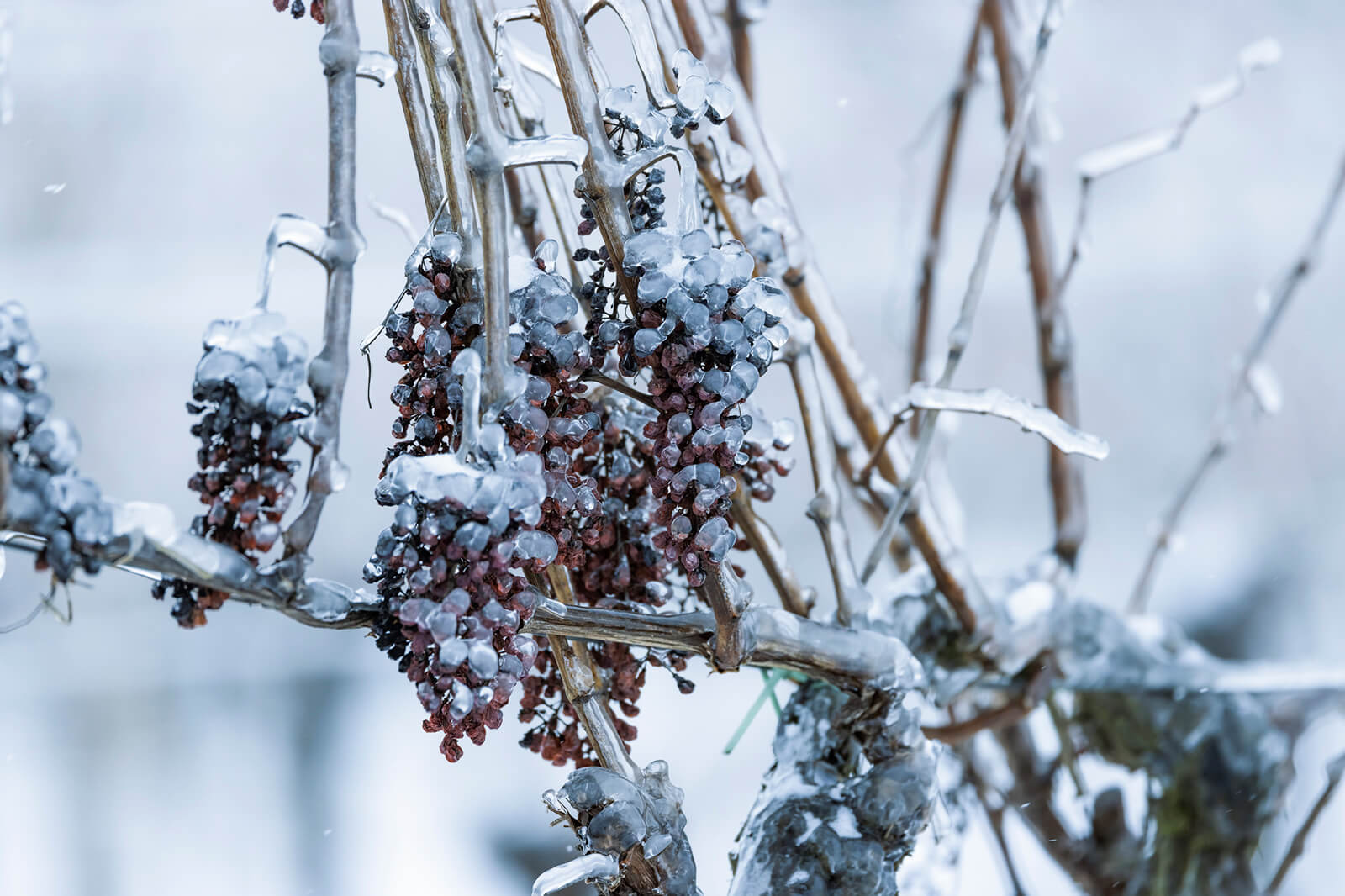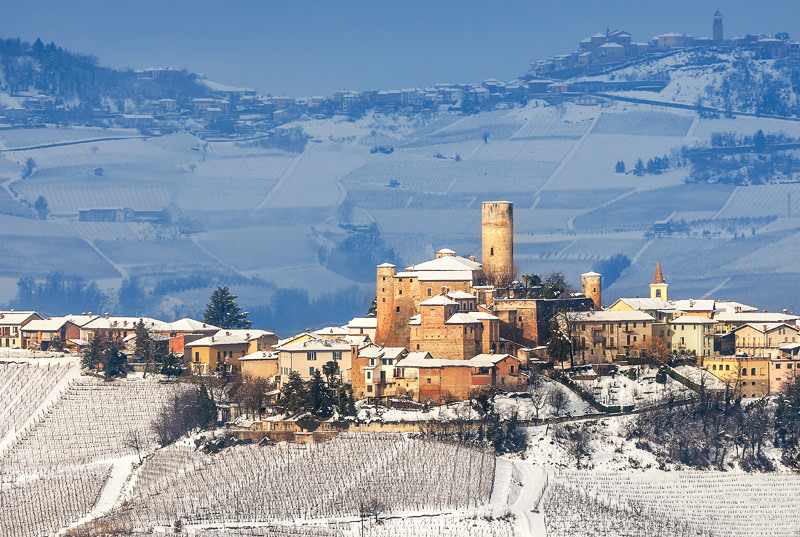Indulge in Winter's Liquid Magic: Ice Wine, Nectar of Winter's Chill

Ice wine, also known as Eiswein in German, is a unique and luxurious type of dessert wine that is produced from grapes that have naturally frozen on the vine. This winemaking process is a delicate dance with winter's chill, as the grapes must freeze while still on the vine to achieve the concentrated sugars and flavors that define ice wine.
Key Characteristics:
- Intense Sweetness: Ice wine is renowned for its intense sweetness, owing to the concentration of sugars in the frozen grapes.
- Flavor Complexity: The freezing process imparts a range of complex flavors, including notes of honey, tropical fruits, and floral undertones.
- Acidity Balance: Despite its sweetness, well-made ice wines maintain a balanced acidity, providing a refreshing contrast to the richness.
Harvesting Process:
- Ice wine production commences well before the harvest, involving meticulous vineyard selection and grape care. The ideal microclimate is one that provides reliable cold temperatures for grapes to freeze on the vine without harming them. Throughout the growing season, careful attention is paid to maintaining healthy grapes that can endure until the first frost.
- Harvesting ice wine grapes demands patience and precision. Timing is critical, waiting for a significant frost at temperatures around -7 to -8 degrees Celsius (19 to 17 degrees Fahrenheit). Hand-picking the frozen grapes during the early morning or overnight ensures their preservation, although this labor-intensive process can be costly.
- Pressing the frozen grapes is the next step, done while they remain frozen to extract concentrated, sugary juice, leaving behind frozen water. Fermentation of this sweet juice follows, a lengthy process due to the high sugar content, often resulting in an alcohol content not exceeding 12%. Alternatively, fermentation may be intentionally halted, creating a sweet wine with relatively low alcohol. After fermentation, the wine undergoes aging, filtration, and strict quality control before bottling. Strict regulations govern the entire process, adding to the complexity, and the unpredictable weather makes ice wine a risky venture for winemakers. However, the rich, sweet, and intensely flavored result makes it a risk many are willing to take.
Production Regions:
Ice wine is produced in regions with cold climates conducive to grape freezing. Notable regions include Germany, Canada (particularly in the Niagara Peninsula), Austria, and the United States (New York and Michigan).
Types of Grapes Used to Make Ice Wine:
- Grapes most commonly used to produce Ice Wine include several cool climate white grapes varieties like Riesling, Vidal Blanc, Gewürztraminer, Grüner Veltliner, and Chenin Blanc. These varietals tend to be naturally more acidic, which helps balance the wine so it’s not as syrupy when production is complete.
- Ice wine can be made from red grape as well; these are often from Cabernet Franc and Merlot.
- New World winemakers are also experimenting with other varieties these days, including Seyval Blanc, Pinot Blanc, and Chardonnay.
Savoring and Enjoying Ice Wine:
- Experience the world of ice wine as a sensory journey, from its visual allure to aromatic richness and captivating flavors. The distinct color, ranging from light yellow to deep gold, hints at grape type and aging. Older ice wines exhibit a darker hue due to oxidation during aging.
- The intense bouquet presents fragrances like lychee, pineapple, apricots, peaches, citrus, and honey, evolving with age into complex notes of dried fruit, nuts, and caramel. In taste, the wine balances intense sweetness with acidity, offering a clean finish.
- Serve ice wine chilled (6-10°C/43-50°F) to enhance acidity, using a small white or dessert wine glass for concentrated aromas. With significant aging potential, ice wine evolves over years or decades, gaining nuanced flavors. Proper storage at a consistent, cool temperature preserves its quality, and the high sugar content allows re-corking and refrigeration for several days after opening without significant flavor loss. Cheers to the evolving symphony of ice wine complexity! 🍷❄️
Snow's Embrace: Nurturing and Navigating Challenges in the Vineyards

As the vineyards lie beneath a serene blanket of snow, the winter spectacle unfolds, offering both protection and posing delicate challenges for the grapevines. In this exploration, we delve into the captivating interplay between snow and vines, acknowledging the nurturing embrace while navigating the potential damages that winter's frozen veil may bring.
1. Insulation and Protection Amidst Challenges:
The snow's gentle touch acts as a natural insulator, safeguarding grapevines from extreme cold temperatures and minimizing the risk of frost damage. However, amidst this protective embrace, challenges emerge, particularly in regions prone to heavy snowfall.
2. Weighty Concerns:
In the face of an unusually heavy snow load, the protective veil transforms into a potential threat. The weight of accumulated snow can stress grapevines, leading to the bending or breaking of branches. Vineyard caretakers must carefully monitor and, if necessary, intervene to alleviate this burden and prevent structural damage.
3. Moisture's Dual Nature:
While snow serves as a reservoir of moisture essential for the vines, prolonged cover can create a damp environment conducive to snow mold or fungal diseases. Striking a delicate balance, vineyard managers implement measures to ensure adequate ventilation, preventing potential damage from excess moisture.
4. Freeze and Thaw:
The whims of fluctuating temperatures, freezing and thawing cycles, introduce a nuanced challenge. When snow melts during warmer spells and refreezes, it can encase the vines in ice, potentially causing harm to buds and shoots. Strategic vineyard management is essential to mitigate risks associated with temperature fluctuations.
5. Guarding Against Winter Desiccation:
In cold, windy regions, snow acts as a shield against winter desiccation, preventing the loss of moisture from the vines. Yet, when snow cover is insufficient, vineyard caretakers implement protective measures to shield the vines from the drying effects of winter winds.
In conclusion, as we appreciate the enchanting beauty of snow-draped vineyards, it's crucial to recognize the dual nature of winter's gift. While providing insulation and protection, snow introduces challenges that demand thoughtful vineyard management. In navigating the potential damages, vineyard caretakers ensure that the grapevines not only endure winter's embrace but also emerge resilient, ready to burst forth with life when the season turns its page.
The picture represents the enchanting snow-covered town of Castiglione Falletto, Piedmont, Italy, renowned for its production of high-quality Barolo wine.
Effervescence Unveiled: A Symphony of Sparkling Wines and Crafting Techniques
In the world of wine, few libations embody celebration and sophistication quite like sparkling wines. These effervescent delights captivate the senses, offering a diverse array of flavors and styles. As we embark on a journey through the world of sparkling wines, we'll explore not only the different types that grace our glasses but also the intricate methods that bring these bubbling beauties to life.
Types of Sparkling Wines:
Champagne: Our exploration begins in the hallowed vineyards of the Champagne region in France. This illustrious terroir gives birth to the world-renowned Champagne, a sparkling wine synonymous with opulence, exclusivity, and the clinking of crystal flutes during joyous celebrations.
Prosecco: Venturing south to Italy, we encounter Prosecco, a charming and fruit-forward sparkling wine crafted primarily from the Glera grape. Its effervescence tells a story of the Italian countryside, and its lighter profile makes it a popular choice for casual toasts and lively gatherings.
Cava: From the sun-soaked vineyards of Spain comes Cava, a sparkling wine with roots in the traditional method akin to Champagne. Crafted with indigenous Spanish grapes, Cava offers a taste of the Iberian Peninsula's rich viticultural heritage.
Sparkling Rosé: The spectrum of sparkling rosé beckons, transcending regions and styles. Whether emanating from the vineyards of Champagne or the hills of Napa Valley, sparkling rosé brings a blush of elegance to the world of effervescence.
Crémant: In the cradle of French winemaking, regions outside Champagne birth Crémant, a term denoting French sparkling wines produced with the traditional method. Each region, from Alsace to Bourgogne, contributes its unique terroir to these sparkling gems.
American Sparkling Wine: Across the Atlantic, American sparkling wines emerge, showcasing the diversity of terroirs from California's Napa Valley to Oregon's Willamette Valley. With a spectrum of grape varieties and winemaking techniques, these wines contribute to the global celebration of effervescence.
Asti (Asti Spumante): Italy beckons once more with Asti, a sweet and bubbly delight crafted from the Moscato Bianco grape. Its slightly sweet profile and lower alcohol content make it a favored choice for those with a penchant for the sweeter side of sparkling wine.
Crafting Techniques:
Traditional Method (Méthode Champenoise or Méthode Traditionnelle): The opulent courts of 17th and 18th century Europe witnessed the birth of the traditional method, forever linking Champagne to regal celebrations. This meticulous process involves a secondary fermentation in individual bottles, imparting complexity and depth to the final creation.
Charmat Method (Tank Method or Metodo Martinotti): Italy's contribution to sparkling wine craftsmanship, the Charmat method, takes a departure from the individual bottle fermentation. Instead, large pressurized tanks become the stage for the secondary fermentation, resulting in the crisp and fruity effervescence characteristic of Prosecco.
Transfer Method: Drawing from the elegance of both traditional and Charmat methods, the transfer method involves the initial fermentation in the bottle, akin to the traditional method. However, after aging, the wine is transferred to a tank, filtered, and then rebottled, marrying the best of both worlds.
Carbonation: For more commercial productions, carbonation takes center stage. This method involves the direct addition of carbon dioxide to the wine, providing a simpler and less labor-intensive approach to effervescence.
In conclusion, as we savor the diversity of sparkling wines and delve into the intricate methods that shape them, it becomes evident that effervescence is not merely a trait; it's a celebration in a glass. From the regal courts of Europe to the sun-drenched vineyards of California, each sip transports us across time and terroir, making every pop of the cork a momentous occasion. Here's to the symphony of sparkling wines, crafted with passion and precision, and the joyous celebrations they inspire!
Bubbles of Tradition: The Historical Tapestry of New Year's Sparkling Wine

As the clock strikes midnight on New Year's Eve, glasses around the world are raised, filled with effervescent joy in the form of sparkling wine. While this tradition is now a global phenomenon, its roots delve deep into history, weaving a tale of celebration, prosperity, and renewal.
The Aristocracy's Affair with Champagne: Our journey into the historical origins of New Year's sparkling wine takes us to the opulent courts of Europe in the 17th and 18th centuries. It was here that Champagne, hailing from the eponymous region in France, became the drink of choice among the aristocracy. Its exclusivity and high cost made it a symbol of wealth and success. The effervescence of Champagne added a touch of magic to royal celebrations, solidifying its association with joyous occasions.
Symbol of Prosperity: Champagne's rise to prominence as a symbol of prosperity persisted over the centuries. The clinking of crystal flutes filled with bubbly became synonymous with toasts for good fortune, success, and opulence. As people around the world embraced the idea of welcoming the New Year with positive vibes, Champagne secured its place as the go-to drink for celebrations.
The Symbolism of Bubbles: Beyond its historical associations, the bubbles in sparkling wine carry a deeper symbolism. As the clock strikes twelve, revelers toast to the end of the old year and the beginning of the new. The effervescence is seen as a representation of renewal—a sparkling cascade of optimism and a fresh start. The act of raising a glass filled with bubbles is a universally recognized gesture of bidding adieu to the past and embracing the possibilities of the future.
Global Popularity and Diverse Bubblies: While Champagne remains an iconic choice, the tradition of toasting with sparkling wine on New Year's Eve has evolved into a global affair. Various sparkling wines from different regions and countries have found their place in this tradition. Prosecco, Cava, and other sparkling varieties contribute to the kaleidoscope of bubbles that signify unity in celebration.
In conclusion, the symphony of clinking glasses and effervescent laughter on New Year's Eve, witnesses a historical tradition that has transcended borders and cultures. Sparkling wine, with its rich tapestry of historical significance, continues to be the companion to our joyous moments, linking the past with the promise of a sparkling future. So, as the clock counts down to midnight, let the bubbles rise, symbolizing not just a drink but a tradition that encapsulates the spirit of celebration, prosperity, and new beginnings. Cheers to the effervescence of tradition!
You know you want to
Sign Up For Our Newsletter
Keep up to date on the latest wine releases, events and promotions.